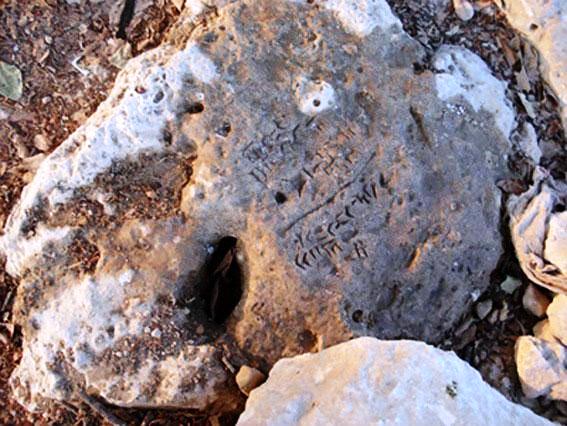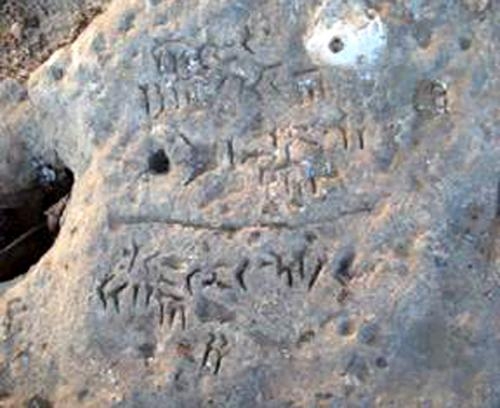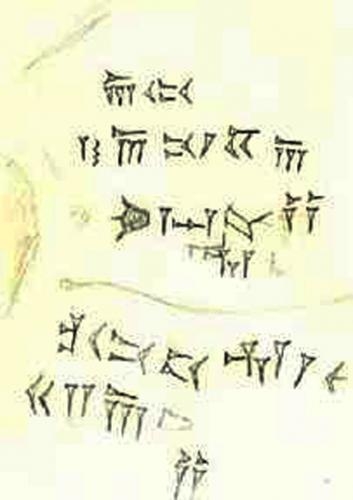The reports below regarding the Old-Persian Cuneiform Inscription of Kharg Island was originally posted in CAIS on December 9, 2007.
Rasool Bashash (Faculty Member, Linguistics, Inscriptions, and Texts Research Center, Research Institute to the Iranian Cultural Heritage, Handicrafts, and Tourism Organization) reported in CAIS (December 9, 2007) that the first person who informed the Linguistics, Inscriptions, and Texts Research Center (LITRC) about the appearance of this inscription was revered Prof. Dr. Sarfaraz, whom we should profoundly appreciate for his opportune attention.
 Kharq cuneiform inscription (Source: CAIS & Cultural Heritage New Agency).
Kharq cuneiform inscription (Source: CAIS & Cultural Heritage New Agency).
In mid-November 2007, Bashash and Sarfaraz along with various other officials and archaeologists arrived at Kharq Island. Bashash gathered all the necessary information and needed provisions and returned to Tehran, to read and decode the inscription.
The inscription is carved on a coral rock in Old Persian semi-syllabic cuneiform signs. Despite the usually well-ordered regular system of Achaemenid inscriptions, this specimen is in an unusual order written in five lines. The first three lines are separated with a space of 8cm from the second two lines which are very awkwardly engraved.
However, the cuneiform signs of the syllables have been very well and correctly engraved. Excepting the aforementioned peculiarities, there are two other engraved signs between the text. One is a three-angled crown-looking sign at the beginning of the third line, and the other is a curved scratched line between the third and fourth lines which is proceeded in below coming paragraphs.
The below coning tentative decoding of the inscription was carried out through referring to almost all Persian rock and artifact inscriptions, while studying, at the same time, the other contemporary and coincidental Elamite and also some Avestan, the Old Persian’s closest cognate language texts.
Transliteration Transcription
1 a ha .ha
2 sa a na . .a a s.na . ..
3 za ha ma i vazahamai
4 ba ha na ma . bahanama
5 xa a x.
 Kharq cuneiform inscription (Source: CAIS & Cultural Heritage New Agency).
Kharq cuneiform inscription (Source: CAIS & Cultural Heritage New Agency).
Translation
“The not irrigated land was (became) happy (with) my bringing out (water). Bahana wells”
 Kharq cuneiform inscription (Source: CAIS & Cultural Heritage New Agency).
Kharq cuneiform inscription (Source: CAIS & Cultural Heritage New Agency).
Commentary
The only one word in the first line is .ha from the radical .ah1, “to be, to become, …”, impf. 3rd sg, “was, became”.
The second line contains two words. One is read as sa a na > s.na. This word was not found in any of the Old Persian cuneiform texts, but in Achaemenid Elamite, either sa-a-in or sa,-in and sa-a-na (PF572:7f;9500:10) are attested and are translated as “not irrigated land”, which serve as qualification of grain, in contrast to HAL.A, meaning “place (of) water”, or “irrigated land”. The second word reads as .. from the ..y. is an adjective meaning “happy, glad”.
The third line, as mentioned, begins with a fallen three-angled crown-looking engraved shape. Actually, it shouldn’t be a real crown, but I prefer to discern it a corruption of the cuneiform sign for the syllable va, and later manipulated into the shape of a crown. Therefore, I suggest a transliteration of the corrupted and broken third line as va za ha ma i > vazahamai, a noun with enclitic first person possessive pronoun: vazah n. from the verb .vaz, meaning “to bring, to offer, to flow”. Vazahamai; “my offer, my flow”.
The fourth line can either be read as the name of a person, transliterated as ba ha na > bahana, with the accusative (-ma), or it can be matched with an Elamite word read as pa ha nu, meaning “prince”.
The last line consists of one word transliterated as xa a > x., which is a noun plural (NP), nominative and accusative of substantive xan, meaning “wells, quells”.



